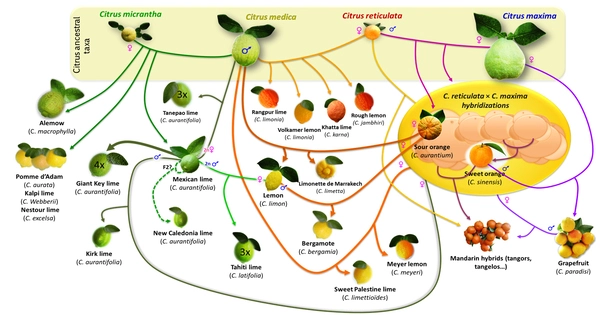Citrus taxonomy is the botanical classification of the species, variations, cultivars, and graft hybrids found in the genus Citrus and related genera, both in cultivation and in the wild. Citrus is a genus of flowering plants in the Rutaceae family, also known as the citrus or rue family. This genus contains numerous well-known fruit-bearing trees and shrubs that are cultivated for their delicious fruits.
Citrus taxonomy is difficult and contentious. Citrus cultivars are derived from numerous citrus species found in the wild. Some are just selections of the original wild varieties, while many others are hybrids between two or more original species, and yet others are backcrossed hybrids between a hybrid and one of the hybrid’s parent species.
Citrus plants easily hybridize between species with very distinct morphologies, and citrus fruits with similar appearances may have very different ancestors. Some merely differ in disease resistance. Different-looking cultivars, on the other hand, may be essentially genetically identical and differ solely by a bud mutation.
Here is a basic overview of citrus taxonomy:
- Kingdom: Plantae – Citrus belongs to the plant kingdom, as it is a group of multicellular, photosynthetic organisms.
- Phylum: Angiosperms (Magnoliophyta) – Citrus plants are angiosperms, which means they produce seeds enclosed within a fruit.
- Class: Eudicots (Magnoliopsida) – Citrus plants are classified as eudicots, one of the two major groups of flowering plants (the other being monocots).
- Order: Sapindales – Citrus is a member of the Sapindales order, which includes a wide range of plants, including those known for their fruit-bearing abilities.
- Family: Rutaceae – Citrus belongs to the Rutaceae family, commonly referred to as the citrus or rue family. This family includes many aromatic plants, including citrus trees and shrubs.
- Genus: Citrus – The genus Citrus includes all the well-known citrus fruits, such as oranges (Citrus × sinensis), lemons (Citrus × limon), limes (Citrus × aurantiifolia), and grapefruits (Citrus × paradisi).
Within the Citrus genus, there are numerous species, hybrids, and cultivars, making the taxonomy of citrus quite complex. The following are some well-known citrus species and hybrids:
- Citrus × aurantiifolia – Key lime or Mexican lime
- Citrus × limon – Lemon
- Citrus × sinensis – Sweet orange
- Citrus × paradisi – Grapefruit
- Citrus × tangerina – Tangerine
- Citrus × reticulata – Mandarin orange
- Citrus × bergamia – Bergamot orange (used for essential oil)
- Citrus × medica – Citron
- Citrus × latifolia – Persian lime (Tahiti lime)
















